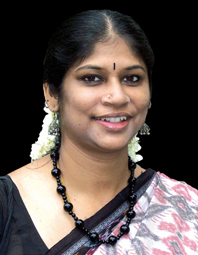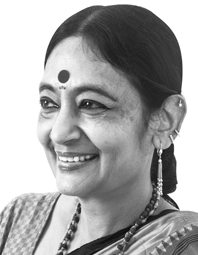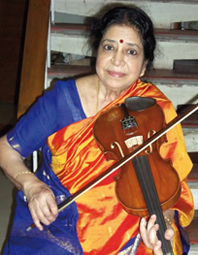COVER STORY - Exotic talent to the fore by T.T. NARENDRAN

Among the sabhas that adorn the city of Chennai, there is this small but beautiful Nada Inbam (NI) with its own Raga Sudha hall, conceived and constructed by its engineer-founder, the late S.V. Krishnan. The sabha has stayed glued to the core values of Carnatic music and largely avoided featuring artists who are popular but do not belong to the genre it seeks to promote. Early in the season there was Rithvik Raja with M. Vijay (violin), Tanjavur Praveen Kumar (mridangam) and Chandrasekhara Sarma (ghatam). This disciple of T.M. Krishna has progressed well over the last couple of years and appears to be a sensitive, thinking musician. He has a bass voice with an intrinsically low volume that makes him vulnerable to the vagaries of the public address system. Both here and at the Sri Parthasarathy Swami Sabha (PSS), where he took the stage with the same team ten days later, he made a good impression. The best of his musical instincts were evident in his alapana of Asaveri (Sree Kanchinayike, Annaswamy Sastry, at NI) and Varali (Eti janmamiti, Tyagaraja at PSS) and rendition of the kriti in Asaveri and of O Jagadamba (Anandabhairavi, Syama Sastry at PSS). A little more power in his voice and more intelligent use of the mike can improve his impact on the audience.
There was an unexpected coincidence with a couple of kritis re-appearing after two days in Nandita Ravi’s concert at this venue (Ee vasudha, Sahana, Tyagaraja and Sree Kanchinayike, Asaveri). She provided vintage classical music. Her alapanas of Sahana, Bhairavi (Chintayama, Dikshitar) and Varali (Eti janmamiti) with bright swara appendages were the mainstay of the concert, which also had an evocative padam (Tiruvotriyur, Athana) and a javali in Khamas as the hallmarks of the school of music she represents. Usha Rajagopalan (violin) supported her well, though her alapana of Bhairavi stretched a bit. B. Sivaraman provided accompaniment appropriate to this style of singing; only the pace of the padam seemed to elude him.
SPOTLIGHT - A Natya Kala Acharya looks back - Sudharani Raghupathy in conversation with S. Janaki

Eminent Bharatanatyam exponent and guru Prof. Sudharani Raghupathy was honoured with Natya Kala Acharya award by the Music Academy at the inaugural function of its Dance Festival on 3 January 2013 in Chennai. A cover story was published earlier in Sruti 169 (October 1998) - now available as Sruti E-Vintage Issue 3 at Sruti Archives - Online. Fifteen years later, the artist who is now 68 years old, looks back with a sense of fulfilment at the years spent in learning, performing, researching and teaching dance.
What does the Natya Kala Acharya award mean to you?
I owe whatever I am today to my guiding lights: the four legends – the Tanjavur Quartet – who paved the path; my three gurus – U.S. Krishna Rao, K.P. Kittappa Pillai and Mylapore Gowri Amma; and two persons – my parents – who introduced me to the art and encouraged me in every way. I am so happy that I am getting this award during the birth centenary of two of my gurus U.S. Krishna Rao and K.P. Kittappa Pillai.
I feel proud to be a representative of the great Tanjavur/ Pandanallur bani of Bharatanatyam. The dance form is visually beautiful and appealing to the mind and is highly popular to this day. It was never meant to be mere entertainment. It requires great sadhana to pursue an art.
It is not an easy life with immediate returns...
No, it is not. The life of an artist finds a metaphor in the metamorphosis of a butterfly. As a student, we voraciously learn, imbibe and endow the mind, body and intellect like the feeding caterpillar. Then there is an introspective period inside the chrysalis – of assimilation, self-evaluation, with a sneak preview or two for a few near and dear ones, like the phase of a clothed cocoon. And then emerges the beautiful butterfly when there is real indulgence and the artist embarks on the colourful journey of natya. Ironically, this could be marked by brevity as it depends on many facets of the dancer – his or her physicality, agility, maturity, attitude and ability – so similar to the lifecycle of a butterfly. Nevertheless, in the words of Tagore, “The butterfly counts not months but moments and has time enough”.
MY GURU - Many strings to her bow by AMRITHA MURALI

T. Rukmini, one of the seniormost violinists in Carnatic music, was one of the recipients of the Sangita Kala Acharya award of the Music Academy last motnh.
The veteran spoke to one of her disciples AMRITHA MURALI at length, reminiscing with joy and the enthusiasm of a child about her long, interesting and successful musical journey. Here are some excerpts:
When did your formal training begin? Were you exposed to music earlier?
Back home in Bangalore, my parents and siblings were very interested in Carnatic music. The radio was our primary source of listening to music. Even as a child, I had the uncanny knack of singing and reproducing verbatim whatever I heard. I distinctly remember that I learnt Manasa guruguha from merely hearing D.K. Pattammal’s recording and could sing it without a blemish. Recognising my passion for the art form and my proclivity towards music, my father wanted me to learn to play an instrument as also train for vocal music. I was given the option of choosing between the veena and the violin and my immediate choice was the violin. Ramaswamy, a student of R.R. Kesavamurthy, lived close by and my initial lessons began under him. I had progressed to learning a number of varnams from him when he and my parents felt that I should proceed to take advanced training from Kesavamurthy who readily consented to take me on as his disciple. There was no looking back from then on.
Could you elaborate on the rigorous training you underwent under Kesavamurthy?
Kesavamurthy, a strict disciplinarian, proficient in both the theory and practice of music, came home to tutor me. He was precise and accurate in whatever he imparted and wouldn’t tolerate even the smallest of errors. Noticing my precocity in playing the violin and grasping subtle nuances he taught me many kritis. He also used to notate every kriti systematically, a practice I have imbibed from him. My mother supervised my practice sessions and it annoyed her if I missed rehearsing even for a day. Despite never having any formal training she had a good ear for music. Her valuable criticism was in fact a source of inspiration. At that stage the opportunity to interact with musicians came when my brother became instrumental in starting the Malleswaram Sangeetha Sabha. Popular musicians of those days frequented my guru’s house and concerts were held at his residence. My guru also felt at this point that I was adequately equipped to participate in competitions. I upheld his trust by bagging several prizes.
CENTENARY FEATURE - A MASTER OF HARIKATHA by SAMUDRI
Mannargudi Sambasiva Bhagavatar (1912 – 2004) was an outstanding exponent of Harikatha kalakshepam for more than five decades. He was also an accomplished performing artist in Carnatic music in the early phase of his life before deciding
in 1954 to devote himself completely to Harikatha, with the blessings of the Paramacharya of Kanchipuram.
Born at Mannargudi in the old Tanjavur District of Madras Presidency in 1912 to Rajam Iyer and Meenakshi Ammal, he had his training in Carnatic music under Ettayapuram Rajagopala Bhagavatar — son of the distinguished Ramachandra Bhagavatar —Dasavadyam Salem Veeraraghava Bhagavatar and finally Sangita Kalanidhi Maharajapuram Viswanatha Iyer. Ramachandra Bhagavatar belonged to the family of Muthuswami Dikshitar. Sambasiva Bhagavatar completely imbibed the texture and spirit of the classical style of Maharajapuram Viswanatha Iyer. He was in the first batch of students at the Annamalai University Music College, but had to discontinue his education there on account of family reasons.
He gave his first Carnatic music concert at the Perambur Sangeeta Sabha, Madras in 1933. He was 21. It was a five-hour programme. Viswanatha Sarma accompanied him on the violin, Ramanathapuram Eswaran on the mridangam, Umayalpuram Viswanatha Iyer on the ghatam, Venu Naicker on the khanjira and Velu Chettiar on the dholak. Tiger Varadachariar strongly recommended Sambasiva Bhagavatar’s name to the Corporation Radio when it was first introduced in the mid-1930s. In 1940, film star M.K. Thyagaraja Bhagavatar sat through the classical music performance of Mannargudi Sambasiva Bhagavatar at Triplicane and paid a wholesome tribute to his exposition of the raga Shanmukhapriya.


